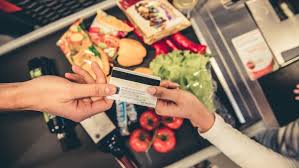
From https://www.cnbc.com/2017/09/19/i-was-shocked-by-how-much-it-turns-out-i-spend-on-food.html
I love food. I love yummy food. I bet you too love food or at the very least, see the need to eat. A variety of studies suggest that many of us around the world spend the majority of our money on food. Perhaps more importantly and sobering is that we tend to waste much of the food that we buy. Food goes bad before we consume it, or we buy things we do not like.

From-https://www.mashed.com/89983/signs-spend-way-much-money-food/
Do you know how much you spend on food? Do you break down your budget to get a sense of how much you spend on eating out – the quick coffee (guilty), casual lunch, etc.?
In 2017, the average family in the U.S spent $7, 729 on food that is about $644 per month.
How much do you spend? We are spending between $240 and $400 for two people, including eating out. There is def more room to cut down our spending, so I am actively thinking about these things.
Thoughts on ways to stay within your food budget in no particular order
- Look at your receipt after every food purchase. Most of the times, people toss their receipt before checking how much they have spent. This is not very wise -for several reasons
- What if the cashier made a mistake and charged you for something you did not buy?
- What if you were overcharged?
- What if your rewards weren’t applied -get that rewards card? I also love keeping coupons for the stores we frequent
- Making a grocery list is the best way to stay within your budget and ensure that you have everything you need. Trust me, it is crucial. For the last few weeks, we kept forgetting to buy butter. Dry toast is a pain
- Be honest about the number of meals you eat at home and how much you eat out. You can tally up food expenditures from your credit/debit card report.
- Be honest about the food that you like and what you hate. The most significant waste on most of our food budgets is ingredients that go bad — the avg. American family is throwing out food worth over $2,000 annually.
- Educate yourself on the real cost of food – the price for bread, milk, eggs, and rice should generally be consistent across stores. If you are paying $5 for a loaf of bread you are probably spending too much -bread in wholefoods ranges from $2-$13 it is tough to imagine why anyone without special dietary needs would pay $13 on a loaf of bread. Eggs vary widely, but I would guess spending $2-$3 on a dozen sounds about right, a gallon of milk in wholefoods Is about $4- I am using wholefoods examples because it is the most expensive store, therefore, if you are buying groceries at a regular store and spending more than these numbers you may not be shopping right.
-
Try to make your lunch: When I worked at the World Bank, I was in love with the cafeteria, BUT I was spending at least $13 on lunch. This is not sustainable. According to the labor stats, people in the U.S. spend over $3k on eating out. The only way I managed this was because I was paying subsidized rent for my friend’s extra-large closet/guest bedroom. I like to keep my lunch simple – 3 pieces of fruit (mostly because I start on my lunch as soon as I get to work. I believe there are support groups for people who do this – do not judge me). A small tin of yogurt and P&B sandwich. No need for reheating (most work microwaves can be nasty) reduce chances of fighting office Becky for eating your lunch lol
*If you do like buying lunch be honest about the cost and factor it into your monthly budget
- Make your meals at home- I am not a good cook, so I understand the anxiety around cooking.
- Benefits of cooking at home
- You know everything that goes into your food
- You can control sodium intake
- Takes less time than eating out
- Can be therapeutic
- Leftovers can make a great lunch option
- You save a lot
- If for some reason your lifestyle (or skillset) does not allow for cooking at home
- Budget your meals and be honest about your expenditures
- Get well acquainted with the food options around you and have a list of budget-friendly options. If you live alone eating out can be good for the budget if you prefer exotic meals with plenty of ingredients
- Buy food you enjoy – the worst is ordering a $20 meal then throwing it all out
- Eat what you buy
- Benefits of cooking at home
- Shop the outside aisles – the middle is packed with items that will hurt your wallet and your health.
- Get to know your grocery store- if you know where the things on your list are located then you will be able to stick to your budget
- Avoid big box stores – this is controversial, but I do find that unless you have a big family shopping at Costco can hurt your budget. Do you really need 20 gallons of spaghetti sauce for two people?
- Try to go to the smaller local stores that offer fewer brand options per product. We have found Trader Joes to be budget-friendly because they have fewer options, and their quantities per item are small enough for us to consume within a week.
- Do buy in bulk dry goods that you use often- we make rice at least 4 times a week, so I get this 10lb bag of rice online from Walmart when we buy our cleaning supplies. There is no difference between Walmart and whole foods rice. Do the same for pasta, spices and any sources you like. In Harare, I go to the Mbare market for all our long shelf veggies and grains. We always get to the market by 7 am for the freshest products and great bargain prices.
- Go to the grocery store just once a week. Yep! You will save a lot of money that way. Of course, we all forget things that we need for a meal but if you can avoid a midweek run do it. We once forgot to buy tomatoes – a midweek run for tomatoes ended up costing us $30 because suddenly we realized all the other things we “absolutely” needed.
- So how much should you spend on food? Try using the 50-20-30 budgeting system where you automatically save 20% of your take-home salary, spend 50% on necessities like housing, debt payment and groceries (10%), and 30% for flexible spending or additional savings.
- More importantly, track your food spending – each family is unique. Health and financial needs shape what we can afford to spend. Don’t stress 🙂 Relax, breathe and then … stick to a single shopping day, write down your grocery list, take note of what you like to eat, and the budget should work out. Honestly, I am not even YOLO about this – honesty with yourself is the first step to making good financial choices.
Chipo confessions: we like wine, we like ice cream, we like salmon, and we buy two different types of bread because -different needs. We have found a way to stay within our $100/week budget even with these splurges.
REMEMBER: I am not a financial advisor these are simply my thoughts

Discussion